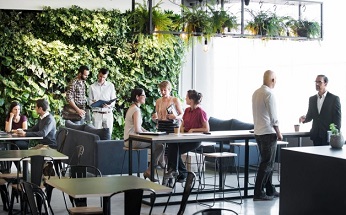 READING, PA.—Ambius, the world’s largest interior landscaping company, premiered their proprietary trends report, a first for the biophilic category that highlights the top six trends in biophilic design that have staying power. These architectural applications are poised to change the way people work and operate within the built environment.
READING, PA.—Ambius, the world’s largest interior landscaping company, premiered their proprietary trends report, a first for the biophilic category that highlights the top six trends in biophilic design that have staying power. These architectural applications are poised to change the way people work and operate within the built environment.
Part of the larger wellness movement, biophilic design integrates nature and natural patterns into building architecture in order to create a human-nature connection that can help positively change the way people work. Research shows that integrating biophilic design into indoor environments positively impacts employees in several ways:
- Reduced employee absenteeism;
- Improved health;
- Increased mood and feeling of well-being;
- Improved productivity;
- Increased employee engagement;
- Reduced stress levels; and
- Mental restoration and reduced fatigue.
Ambius’ 2019 Biophilic Design Trends Report explores the leading design elements that will change the way people work, engage, and perform in the built environment,” said Kenneth Freeman, Head of Innovation, Ambius. “The aesthetic power that plants can bring to a business has long been recognized and those who choose to enhance their workspaces with a variety of natural design elements, will see the dramatic health and wellness benefits to their overall employee base.”
Six Trends in Biophilic Design
In collaboration with an elite team of design experts that cover large, small, and emerging markets throughout the United States and Canada, Ambius identified the following six trends in biophilic design that are changing the built environment.
Trend 1: Sustainably-Sourced and Reclaimed Woods—Wood may be the most popular of the biophilically-designed construction elements. From simple aesthetic flourishes to large-scale architectural installments, wood is a central part of the biophilic revolution.
Trend 2: Eye to the Sky—Ceilings are having their moment in the design spotlight. From hanging plants and skylights to statement ceiling designs and circadian lighting installations, the ceiling is the next frontier for interior designers and architects.
Trend 3: Green Integration—Trends data suggests that architects and designers are increasingly integrating plants, green walls, large green installations, and more into designs during pre-construction and renovations, rather than adding them post-completion as secondary aesthetic choice.
Trend 4: Lighting 2.0 Introducing Biodynamic Lighting—Biodynamic lighting is the next evolution of commercial lighting. This trend introduces lighting systems that mirror natural sunlight conditions within the built environment which help to regulate the human body’s natural circadian rhythm.
Trend 5: Divide and Prosper—Green wall dividers, a revolutionary new space-enhancing element that provides resolution to many of the challenges facing open office environments everywhere, are agile and adaptable for dynamic work spaces while also incorporating a natural biophilic component at minimal cost and invasiveness.
Trend 6: Flooring and Restoring—Carpet and flooring designers are incorporating uniquely biophilic design characteristics such as natural stone, wood, forest floors, and more into their concepts. The goal is to create natural textures for floors that have the same distinct qualities as natural environments such as the forest floor, a meadow, or a riverbed.
To view the complete “Biophilic Design Trends Report,” click here.






